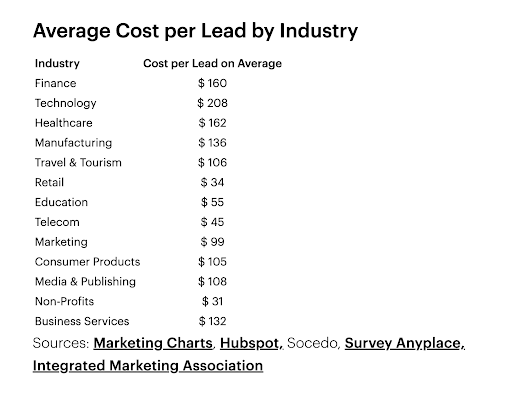Budgets for startup marketing are always a little tricky, and very fluid. However, when you have a tight budget, staying on that budget is incredibly important.
Some of the challenges you might face when developing your budget include: a lack of data (what was last year’s avg CPL [cost per lead]? Beats me!), unrealistic expectations ($2K should cover that tradeshow and private happy hour, right?), and my personal nemesis, “I don’t know where to start” syndrome (Leads? What are leads?).
One of the more paralyzing questions that derail me is, does strategy come first, or the budget? Chicken or egg? In startups, I tend to focus on budget first to inform my strategy. In bigger organizations, or if you’re super lucky, it might go the other way.
As a starting point, research suggests that startup marketing budgets, on average, are 11.2% of your revenue goal.
My goal here is to share the steps I use when working on budget for a pre-seed startup (yup, I seem to like early stage drama). You may be working at a later stage startup with more background, but these steps (I think) are helpful to look at for anyone marketing on a budget.
Look internally to pick marketing tactics
The best way to develop a budget is to look at what you’ve done in the past that worked (rinse and repeat) or didn’t (scrap it). If you have the luxury of knowing your average CPL, use that as a jumping-off point. If you don’t, it’s ok. You can use other metrics to work backwards, such as:
1. What are your sales goals?
Marketing is increasingly tied to revenue as a KPI, and that doesn’t change for the startup world. Working backwards from sales goals is the best way to get a clear answer to the old, “how many leads do we need to generate” question.
Look at last year’s numbers – how many leads did you generate and how many deals came from those leads? Typically, sales goals increase quarter over quarter, so make sure your lead goals are set up similarly.
If you don’t have historical data, do your best to hypothesize about your conversion rate. It could look something like this:
- Sales goals: Close 30 deals (fiscal year)
- # of opportunities needed: 40 (75% conversion of opportunity to closed)
- # of leads needed: 200 (20% conversion of leads to opportunities)
Your funnel might look different, or be more complicated, but you get the idea. Start from your sales numbers, work backwards using logical conversion rates and do your best to come up with a number you can hit.
2. Are all leads created equal, or do certain sources have more value?
Now that you have a logical lead number, the next step is to figure out your best source of leads. Marketing on a budget can be a bit of a balancing act, because you always want to give your sales team the best leads, but the best leads are also expensive. You might not be able to get two hundred of them when the cost per lead is too high.
Your goal is to get to a reasonable average CPL that won’t blow up your budget while also making sure your lead generation is efficient.
Let’s say you need those two hundred leads, and digital marketing will give you THE BEST leads, but they cost $100 per lead. Can you afford $20K for lead gen this year? Great! Go for it. If you can’t, try mixing up the sources. Email marketing might be lower quality, but higher volume leads.
3. How big is your average sale?
Speaking of your cost per lead, do you even have a goal for this? If not, look at your revenue again. If your business is selling $10 widgets, you want low cost, high volume leads. But if your business is doing $100K deals (fancy you!), you probably need a lower volume of leads, but higher quality and at a higher cost.
Hey friends, what’s your marketing strategy?
It’s easy to get caught up with your internal numbers, but it’s important to look externally as well. If you lose sight of your competitor’s strategy, you might miss some opportunities for a high return on investment. And if you don’t have a solid handle on your cost per lead, well, you can do some research on your industry to get some external references.
4. What are your competitors doing?
There are some quick ways to see what your competitors are up to. There are also tools that can help. A few things to look for: do they have super weak PPC campaigns and poor SEO? These might be places where you want to put some budget. Our friends at Hubspot have a nice kit you can use to get started.
5. What is your industry average for CPL?
This is one of those “take it with a grain of salt” metrics, but it’s good to know if you’re way over or under-spending. While a lot of factors go into CPL, I did find this super-handy chart:

Source: https://popupsmart.com/blog/how-much-does-lead-generation-cost
Ask yourself, what are your must-haves?
This is a biggie. It can be as simple as understanding the “we do this every year like clockwork” events, or it can be more complex based on your product or service. Questions I have asked myself include:
6. Is there an industry event we can’t miss?
For example, in my industry EVERYONE goes to HIMSS. It’s expensive, but it’s an important event for us to show our face. That has to be worked into the budget.
7. Does your product require educating the market?
Does your new widget do something new that nothing else ever did? Or did you build a better mousetrap?
If you built a better mousetrap, you’ll spend your time convincing people that yours is the best – so likely you’ll spend a lot on video advertisements and digital campaigns to drive people to purchase pages. But if you built something new, then you need to educate the market, so you’ll spend more time on explaining what your widget is and why it matters (yay, content!).
This is not to say every company shouldn’t have a good mix of digital and content marketing. However, your industry, target customer and competitors will impact where and how you spend your budget.
8. Who are you selling to?
I’ve worked exclusively in B2B, so I admit my approach is colored by that. But regardless of B2B vs B2C, you have to have a good handle on who your customer is and how they consume information.
9. Where do your customers live?
Not actually live, you creeper. Where do they spend their time? Some customer groups lean towards social media, while others read trade pubs. Do your best to build personas, figure out where those personas go for their information (or their fun), and build that into your marketing strategy (and budget).
Some of these questions might seem obvious, but there are many times in startup life where the obvious gets missed because you’re juggling so many things. It’s okay, we’re here for you!
What tech stack do you need?
Finally, my favorite part! All these lead generation tactics don’t happen without a solid tech stack, and with CMOs reporting that 26.6% of their budget goes to martech, it’s a significant expense. Here are some soul-searching questions for you:
How fast do we expect to grow?
This is important as it will decide your first martech stack decision: do you build a stack of less expensive point applications or do you start fast with one of the big players, like HubSpot, Marketo, or Eloqua?
If you’re thinking, within the next year, we’re going to outgrow our piecemeal tech stack, then maybe look at one of the bigger players. Take it from me, you don’t want to go through a martech migration in the middle of a growth period.
But if turning that particular corner is still a few blocks away, you might be better off saving the budget and going with the smaller, less expensive options, knowing that it’s not your forever tech stack.
HubSpot throws a wrench in those plans with their Hubspot for Startups discount. It is a great way to get started on your big-kid martech at a much lower cost. Just be warned, the discounts drop off every year, and you may or may not be eligible depending on your funding.
If you’re not sure where to get started, check out my buddy Tyler’s advice on 10 pitfalls to avoid when building your martech stack.
In general, deciding on a budget in a vacuum is hard, and not recommended. Work with your counterpart in sales and with your management team. Be clear about what results are expected based on the numbers you’ve already expertly put together to justify any costs. And as always, check back with us to see if we can help!













